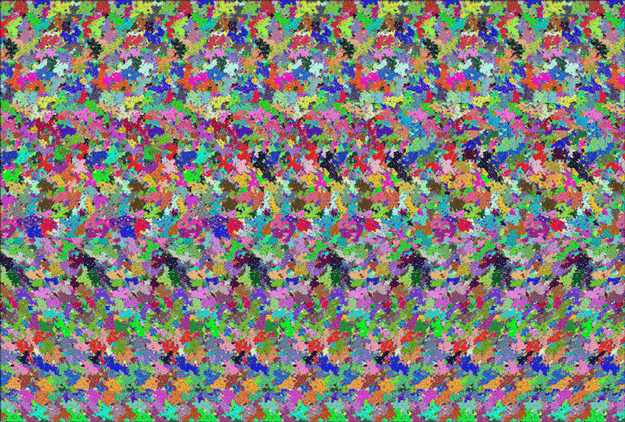|
quanta-m |
|
|
holo-facts
|
||||||
|
|
|
|
||||
|
However, some prisoners may escape from the cave; they may go out into the light of the sun and behold true reality. When
they try to go back into the cave and tell the other captives the truth, they are mocked as madmen.
Of course, to Plato this story was just meant to symbolize mankind's struggle to reach enlightenment and understanding
through reasoning and open-mindedness. We are all initially prisoners and the tangible world is our cave. Just as some
prisoners may escape out into the sun, so may some people amass knowledge and ascend into the light of true reality.
What is equally interesting is the literal interpretation of Plato's tale: The idea that reality could be represented
completely as `shadows' on the walls.
In 1993 the famous Dutch theoretical physicist G. 't Hooft put forward a bold proposal which is reminiscent of Plato's
Allegory of the Cave. This proposal, which is known as the Holographic Principle, consists of two basic assertions:
Assertion 1 The first assertion of the Holographic Principle is that all of the information contained in some region
of space can be represented as a `Hologram' - a theory which `lives' on the boundary of that region. For example, if the region
of space in question is the DAMTP Tearoom, then the holographic principle asserts that all of the physics which takes place
in the DAMTP Tearoom can be represented by a theory which is defined on the walls of the Tearoom. Assertion 2 The second assertion of the Holographic Principle is that the theory on the boundary of the region of
space in question should contain at most one degree of freedom per Planck area.
A Planck area is the area enclosed by a little square which has side length equal to the Planck length, a basic
unit of length which is usually denoted Lp. The Planck length is a fundamental unit of length, because
it is the parameter with the dimensions of length which can be constructed out of the basic constants G (Newton's constant
for the strength of gravitational interactions), To many people, the Holographic Principle seems strange and counterintuitive: How could all of the physics which takes
place in a given room be equivalent to some physics defined on the walls of the room? Could all of the information contained
in your body actually be represented by your `shadow'?
In fact, the way in which the Holographic Principle appears in M-theory is much more subtle. In M-theory we are
the shadows on the wall. The `room' is some larger, five-dimensional spacetime and our four-dimensional world is just the
boundary of this larger space. If we try to move away from the wall, we are moving into an extra dimension of space - a fifth
dimension. In fact, people have recently been trying to think of ways in which we might actually experimentally `probe' this
fifth dimension.
At the heart of many of these exciting ideas is a version of the Holographic Principle known as the adS/CFT correspondence.
The adS/CFT correspondence is a type of duality, which states that two apparently distinct physical theories are actually
equivalent. On one side of this duality is the physics of gravity in a spacetime known as anti-de Sitter space (adS).
Five-dimensional anti-de Sitter space has a boundary which is four-dimensional, and in a certain limit looks like flat spacetime
with one time and three space directions. The adS/CFT correspondence states that the physics of gravity in five-dimensional
anti-de Sitter space, is equivalent to a certain supersymmetric Yang-Mills theory which is defined on the boundary of adS.
This Yang-Mills theory is thus a `hologram' of the physics which is happening in five dimensions. The Yang-Mills theory has
gauge group SU(N), where N is very large, and it is said to be `supersymmetric' because it has a symmetry
which allows you to exchange bosons and fermions. The hope is that this theory will eventually teach us something about QCD
(quantum chromodynamics), which is a gauge theory with gauge group SU(3). QCD describes interactions between quarks.
However, QCD has much less symmetry than the theory defined on the boundary of adS; for example, QCD has no supersymmetry.
Furthermore, we still don't know how to incorporate a crucial property of QCD, known as asymptotic freedom.
If the above picture is your idea of an atom, with electrons looping around the nucleus, you are about 70
years out of date. It's time to open your eyes to the modern world of quantum mechanics! The picture below shows some
plots of where you would most likely find an electron in a hydrogen atom (the nucleus is at the center of each plot). What is quantum mechanics? Simply put, quantum mechanics is the study of matter and radiation at an atomic level. Why was quantum mechanics developed? In the early 20th century some experiments produced results which could not be explained by classical physics
(the science developed by Galileo Galilei, Isaac Newton, etc.). For instance, it was well known that electrons orbited the
nucleus of an atom. However, if they did so in a manner which resembled the planets orbiting the sun, classical physics predicted
that the electrons would spiral in and crash into the nucleus within a fraction of a second. Obviously that doesn't happen,
or life as we know it would not exist. (Chemistry depends upon the interaction of the electrons in atoms, and life depends
upon chemistry). That incorrect prediction, along with some other experiments that classical physics could not explain, showed
scientists that something new was needed to explain science at the atomic level. If classical physics is wrong, why do we still use it? Classical physics is a flawed theory, but it is only dramatically flawed when dealing with the very
small (atomic size, where quantum mechanics is used) or the very fast (near the speed of light, where relativity takes over).
For everyday things, which are much larger than atoms and much slower than the speed of light, classical physics does an excellent
job. Plus, it is much easier to use than either quantum mechanics or relativity (each of which require an extensive amount
of math). What is the importance of quantum mechanics? The following are among the most important things which quantum mechanics can describe while classical physics
cannot: If you look at the spectrum of light emitted by energetic atoms (such as the orange-yellow light from sodium
vapor street lights, or the blue-white light from mercury vapor lamps) you will notice that it is composed of individual lines
of different colors. These lines represent the discrete energy levels of the electrons in those excited atoms. When an electron
in a high energy state jumps down to a lower one, the atom emits a photon of light which corresponds to the exact energy difference
of those two levels (conservation of energy). The bigger the energy difference, the more energetic the photon will be, and
the closer its color will be to the violet end of the spectrum. If electrons were not restricted to discrete energy levels,
the spectrum from an excited atom would be a continuous spread of colors from red to violet with no individual lines. The concept of discrete energy levels can be demonstrated with a 3-way light bulb. A 40/75/115 watt bulb
can only shine light at those three wattage's, and when you switch from one setting to the next, the power immediately jumps
to the new setting instead of just gradually increasing. It is the fact that electrons can only exist at discrete energy levels which prevents them from spiraling
into the nucleus, as classical physics predicts. And it is this quantization of energy, along with some other atomic properties
that are quantized, which gives quantum mechanics its name. The wave-particle duality of light and matter In 1690 Christiaan Huygens theorized that light was composed of waves, while in 1704 Isaac Newton explained
that light was made of tiny particles. Experiments supported each of their theories. However, neither a completely-particle
theory nor a completely-wave theory could explain all of the phenomena associated with light! So scientists began to
think of light as both a particle and a wave. In 1923 Louis de Broglie hypothesized that a material particle could
also exhibit wavelike properties, and in 1927 it was shown (by Davisson and Germer) that electrons can indeed behave like
waves. How can something be both a particle and a wave at the same time? For one thing, it is incorrect to think
of light as a stream of particles moving up and down in a wavelike manner. Actually, light and matter exist as particles;
what behaves like a wave is the probability of where that particle will be. The reason light sometimes appears to act
as a wave is because we are noticing the accumulation of many of the light particles distributed over the probabilities of
where each particle could be. For instance, suppose we had a dart-throwing machine that had a 5% chance of hitting the bulls-eye and a
95% chance of hitting the outer ring and no chance of hitting any other place on the dart board. Now, suppose we let the machine
throw 100 darts, keeping all of them stuck in the board. We can see each individual dart (so we know they behave like a particle)
but we can also see a pattern on the board of a large ring of darts surrounding a small cluster in the middle. This pattern
is the accumulation of the individual darts over the probabilities of where each dart could have landed, and represents the
'wavelike' behavior of the darts. Get it? This is one of the most interesting phenomena to arise from quantum mechanics; without it computer chips
would not exist, and a 'personal' computer would probably take up an entire room. As stated above, a wave determines the probability
of where a particle will be. When that probability wave encounters an energy barrier most of the wave will be reflected back,
but a small portion of it will 'leak' into the barrier. If the barrier is small enough, the wave that leaked through will
continue on the other side of it. Even though the particle doesn't have enough energy to get over the barrier, there is still
a small probability that it can 'tunnel' through it! Let's say you are throwing a rubber ball against a wall. You know you don't have enough energy to throw it
through the wall, so you always expect it to bounce back. Quantum mechanics, however, says that there is a small probability
that the ball could go right through the wall (without damaging the wall) and continue its flight on the other side! With
something as large as a rubber ball, though, that probability is so small that you could throw the ball for billions of years
and never see it go through the wall. But with something as tiny as an electron, tunneling is an everyday occurrence. On the flip side of tunneling, when a particle encounters a drop in energy there is a small probability
that it will be reflected. In other words, if you were rolling a marble off a flat level table, there is a small chance that
when the marble reached the edge it would bounce back instead of dropping to the floor! Again, for something as large as a
marble you'll probably never see something like that happen, but for photons (the massless particles of light) it is a very
real occurrence. The Heisenberg uncertainty principle People are familiar with measuring things in the macroscopic world around them. Someone pulls out a tape
measure and determines the length of a table. A state trooper aims his radar gun at a car and knows what direction the car
is traveling, as well as how fast. They get the information they want and don't worry whether the measurement itself has changed
what they were measuring. After all, what would be the sense in determining that a table is 80 cm long if the very act of
measuring it changed its length! At the atomic scale of quantum mechanics, however, measurement becomes a very delicate process. Let's say
you want to find out where an electron is and where it is going (that trooper has a feeling that any electron he catches will
be going faster than the local speed limit). How would you do it? Get a super high powered magnifier and look for it? The
very act of looking depends upon light, which is made of photons, and these photons could have enough momentum that
once they hit the electron they would change its course! It's like rolling the cue ball across a billiard table and trying
to discover where it is going by bouncing the 8-ball off of it; by making the measurement with the 8-ball you have certainly
altered the course of the cue ball. You may have discovered where the cue ball was, but now have no idea of where it is going
(because you were measuring with the 8-ball instead of actually looking at the table). Werner Heisenberg was the first to realize that certain pairs of measurements have an intrinsic uncertainty
associated with them. For instance, if you have a very good idea of where something is located, then, to a certain degree,
you must have a poor idea of how fast it is moving or in what direction. We don't notice this in everyday life because any
inherent uncertainty from Heisenberg's principle is well within the acceptable accuracy we desire. For example, you may see
a parked car and think you know exactly where it is and exactly how fast it is moving. But would you really know those things
exactly? If you were to measure the position of the car to an accuracy of a billionth of a billionth of a centimeter,
you would be trying to measure the positions of the individual atoms which make up the car, and those atoms would be jiggling
around just because the temperature of the car was above absolute zero! Heisenberg's uncertainty principle completely flies in the face of classical physics. After all, the very
foundation of science is the ability to measure things accurately, and now quantum mechanics is saying that it's impossible
to get those measurements exact! But the Heisenberg uncertainty principle is a fact of nature, and it would be impossible
to build a measuring device which could get around it. In 1922 Otto Stern and Walther Gerlach performed an experiment whose results could not be explained by classical
physics. Their experiment indicated that atomic particles possess an intrinsic angular momentum, or spin, and that
this spin is quantized (that is, it can only have certain discrete values). Spin is a completely quantum mechanical property
of a particle and cannot be explained in any way by classical physics. It is important to realize that the spin of an atomic particle is not a measure of how it is spinning! In
fact, it is impossible to tell whether something as small as an electron is spinning at all! The word 'spin' is just a convenient
way of talking about the intrinsic angular momentum of a particle. Magnetic resonance imaging (MRI) uses the fact that under certain conditions the spin of hydrogen nuclei
can be 'flipped' from one state to another. By measuring the location of these flips, a picture can be formed of where the
hydrogen atoms (mainly as a part of water) are in a body. Since tumors tend to have a different water concentration from the
surrounding tissue, they would stand out in such a picture. What is the Schrödinger equation? Every quantum particle is characterized by a wave function. In 1925 Erwin Schrödinger developed the differential
equation which describes the evolution of those wave functions. By using Schrödinger's equation scientists can find the wave
function which solves a particular problem in quantum mechanics. Unfortunately, it is usually impossible to find an exact
solution to the equation, so certain assumptions are used in order to obtain an approximate answer for the particular problem.
What is a wave packet? As mentioned earlier, the Schrödinger equation for a particular problem cannot always be solved exactly.
However, when there is no force acting upon a particle its potential energy is zero and the Schrödinger equation for the particle
can be exactly solved. The solution to this 'free' particle is something known as a wave packet (which initially looks
just like a Gaussian bell curve). Wave packets, therefore, can provide a useful way to find approximate solutions to problems
which otherwise could not be easily solved.
Answer provided by Lynn Cominsky (SSU E/PO Director): A common event often mistaken by people in the sky to be a Gamma-Ray burst is an Iridium Flare. If you visit this link
http://www.heavens-above.com, then put in your latitude and longitude, you will be able to see if there were any of these flares reported during this
time. Fomalhaut, a 200-million-year-old
star, is a mere infant compared to our own 4.5-billion-year-old Sun. It resides 25 light-years away from the Sun. Located
in the constellation Piscis Austrinus (the Southern Fish), the Fomalhaut ring is ten times as old as debris disks seen previously
around the stars AU Microscopii and Beta Pictoris, where planets may still be forming. If our solar system is any example,
planets should have formed around Fomalhaut within tens of millions of years after the birth of the star. The Hubble images also provide a glimpse of the outer planetary region
surrounding a star other than our Sun. Many of the more than 100 planets detected beyond our solar system are orbiting close
to their stars. Most of the current planet-detecting techniques favor finding planets that are close to their stars. "The size of Fomalhaut's dust ring suggests that not all planetary
systems form and evolve in the same way — planetary architectures can be quite different from star to star," Kalas explained.
"While Fomalhaut's ring is analogous to the Kuiper Belt, its diameter is four times greater than that of the Kuiper Belt."The astronomers used the Advanced Camera for Surveys' (ACS) coronagraph
aboard Hubble to block out the light from the bright star so they could see details in the faint ring. Doomed Star Eta Carinae Even though Eta Carinae is more than 8,000 light-years away,
features 10 billion miles across (about the diameter of our solar system) can be distinguished. Eta Carinae suffered giant
outburst about 150 years ago, when it became one of the brightest stars in the southern sky. Though the star released as much
visible light as a supernova explosion, it survived the outburst. Somehow, the explosion produced two lobes and a large, thin
equatorial disk, all moving outward at about 1.5 million miles per hour. Estimated to be 100 times heftier than our Sun, Eta
Carinae may be one of the most massive stars in our galaxy. 
Our Business Philosophy
|
||||||











 Imagine trekking in a lunar rover across miles of the Moon's rough surface. Your mission: to explore a crater with suspected
deposits of ice.
Imagine trekking in a lunar rover across miles of the Moon's rough surface. Your mission: to explore a crater with suspected
deposits of ice.  The Vision for Space Exploration calls for human and robotic missions to the Moon, Mars and beyond. To realize these ambitious
goals, we will need more powerful and efficient propulsion and power-generation systems -- systems that can thrust a spacecraft
out of Earth's orbit to the far reaches of the Universe.
The Vision for Space Exploration calls for human and robotic missions to the Moon, Mars and beyond. To realize these ambitious
goals, we will need more powerful and efficient propulsion and power-generation systems -- systems that can thrust a spacecraft
out of Earth's orbit to the far reaches of the Universe.